|
Robert "Rocket" Stephenson
| Birthplace: |
Willington Quay, Northumberland, England |
| Death: |
Died October 12, 1859 in at his own home at 34 Gloucester Square, London, England |
On 17 June 1829 he married Frances Sanderson but they had no children.
| Place of Burial: |
Westminster Abbey, England |
University: University of Edinburgh
Was a UK Member of Parliament 1847-59, Whitby
Royal Society
Robert Stephenson FRS (16 October 1803 – 12 October 1859) was an English civil engineer. He was the only son of George Stephenson, the famed locomotive builder and railway engineer; many of the achievements popularly credited to his father were the joint efforts of father and son.
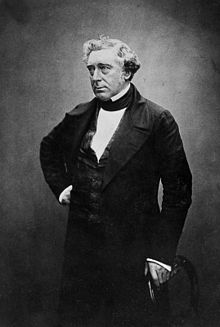
Robert Stephenson was born on 16 October 1803, at Willington Quay, east of Newcastle Upon Tyne, the only son of George Stephenson and his wife, Fanny. At the time, George and Fanny were living in a single room and George was working as a brakesman on a stationary colliery engine. In 1804, the family moved to a cottage in West Moor when George was made brakeman at West Moor Colliery. In 1805 Fanny gave birth to a daughter who died after a few weeks. The next year Robert’s mother died of tuberculosis. George then went and worked in Scotland for a short time, leaving the infant Robert with a local woman. However, George soon returned to West Moor, and his sister Nelly came to live at the cottage to look after Robert.
George had received little formal education and he was determined that his son would have the education that he lacked. At a young age, George expected Robert to read books that were extremely difficult and to learn how to read technical drawings. Father and son studied together in the evenings, improving George’s understanding of science as well as Robert’s. They also built a sundial together, which they placed above the front door of their cottage. The cottage subsequently became known as "Dial Cottage", and is preserved today as a monument to them.[1]
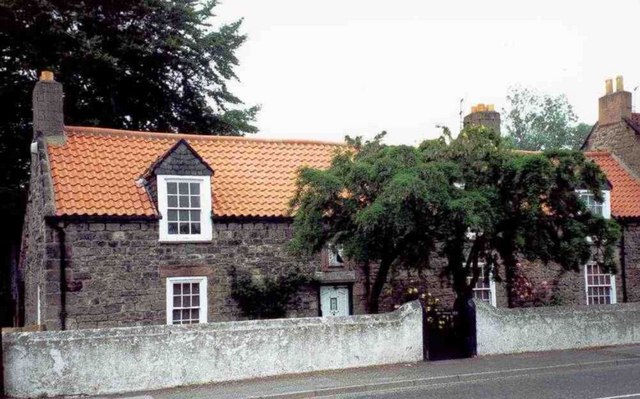
Dial Cottage, West Moor
Because of his great aptitude for engineering, George was promoted in 1812 to be an enginewright at Killingworth Colliery, a skilled job with responsibility for the maintenance and repair of the colliery machinery. His wages were therefore much improved. Robert was sent to a two-room primary school run by Mr. and Mrs. Rutter in Longbenton, near Killingworth until the age of eleven. George's success in locomotive engineering gave him the ability to enroll Robert in a private academy. He was then sent to Doctor Bruce’s Academy in Percy Street, Newcastle. This was a private institution and Robert would have been studying alongside the children of well-off families. Surprisingly his fellow pupils failed to see any remarkable signs of talent. Whilst at the Academy, Robert became a reading member of the nearby Literary and Philosophical Society. Robert had minimal education compared to today's engineers, but proved to be a very successful engineer.
After his education at the Bruce Academy, Robert served an apprenticeship to Nicholas Wood, the manager of Killingworth Colliery, and a period at the University of Edinburgh where he met George Parker Bidder.[citation needed] Robert then went to work with his father on railway projects, the first being the Stockton and Darlington Railway. In 1823, when he was 20, Robert set up a company in partnership with his father, plus Michael Longridge and Edward Pease, to build railway locomotives. On an early trade card, Robert Stephenson & Co were described as "Engineers, Millwrights & Machinists, Brass & Iron Founders.[2]
After six months of education from Edinburgh, Stephenson was able to manage his newly established firm of Robert Stephenson and Company, which was situated in South Street, off Forth Street in Newcastle. The Forth Street Works were the first locomotive works in the world, and it was here that the locomotives for the Stockton and Darlington Railway were built. The first locomotives produced there were called Locomotion No 1, Hope, Diligence and Black Diamond. The Forth Street works continued to build locomotives until the mid-20th century, and the original factory building still exists, at Forth Street in Newcastle, as the Robert Stephenson Centre. George used Locomotion in 1825 for the opening of the Stockton and Darlington line, which Robert had helped to survey.
In 1824, a year before the Stockton and Darlington line opened, Robert went off to South America for three years, to work as an engineer in the Colombian gold mines. His decision seems unusual, and there have been suggestions that it was caused by a rift with his father, but there is no evidence of this. When he returned in 1827, his father was building the Liverpool and Manchester Railway. George was living in Liverpool directing proceedings, so Robert took charge at the Forth Street Works and worked on the development of a locomotive to compete in the forthcoming Rainhill Trials, intended to choose a locomotive design to be used on the new railway.
The result was the Rocket, which had a multi-tubular boiler to obtain maximum steam pressure from the exhaust gases. Rocket competed successfully in the Rainhill Trials, whereas none of its competitors completed the trial. The Liverpool and Manchester Railway opened in 1830, with a procession of eight trains setting out from Liverpool. George led the parade, driving the Northumbrian, Robert drove the Phoenix and Joseph Locke drove the Rocket. Following its success, the company built locomotives for other newly-established railways, including the Leicester and Swannington Railway. It became necessary to extend the Forth Street Works to accommodate the increased work.
On 17 June 1829, Robert married Frances Sanderson in London. The couple went to live at 5 Greenfield Place, off Westgate Road in Newcastle. In 1842, Robert’s wife, "Fanny" as she was known, died. They had no children and Robert never re-married.
In 1830, Robert designed Planet, a much more advanced locomotive than Rocket. Stephenson’s company was by then experiencing stiff competition from other locomotive manufacturers. Up until then, locomotives had their cylinders placed outside the wheels, as this was the easiest arrangement. It was thought that, placing the cylinders inside the wheels was a more efficient arrangement and this was done on Planet. However there was thought to be an increased risk of broken crank axles. There was friction between Robert and his father over this question. The locomotive, when completed, was found to produce much more power than previous designs. It was used on the Camden and Amboy Railway in the US.
In 1833, Robert was given the post of Chief Engineer for the London and Birmingham Railway, the first main-line railway to enter London, and the initial section of the West Coast Main Line. That same year, Robert and his wife moved to London to live. The new line posed a number of difficult civil engineering challenges, most notably Kilsby Tunnel, and was completed in 1838. Stephenson was directly responsible for the tunnel under Primrose Hill, which required excavation by shafts. For the incline from Euston Station to Chalk Farm, Stephenson devised a system that would draw trains up the hill by a rope using a stationary steam engine near The Roundhouse. This impressive structure remains in use today as an Arts Centre. The London and Birmingham Railway was completed at an enormous cost of £5.5 million, compared with the cost of £900,000 for the Liverpool and Manchester Railway.
In 1838, Robert was summoned to Tuscany by Emanuele Fenzi and Pietro Senn to direct the works for the Leopolda railway. The success attained in this first Tuscan experiment in railways led the Russian princes Anatolio Demidoff and Giuseppe Poniatowski to commission Stephenson to construct a railway to Forlì, passing through the Muraglione Pass. Although this railway was not built, it was to all effects the first project for what was to become, almost forty years later, the Faentina railway.
Robert Stephenson constructed a number of well-known bridges to carry the new railway lines, following the experience of his father on the Stockton and Darlington line. George Stephenson built the famous Gaunless Bridge (which was dismantled and reassembled and is now in the car park of the York Railway Museum) for example, a very early wrought and cast iron structure. He also designed the many bridges needed for the Liverpool and Manchester line, opened in 1830.
In 1850, the railway from London to Scotland via Newcastle was completed. This required new bridges for both the Tyne and the Tweed rivers. He designed the High Level Bridge, at Newcastle upon Tyne as a two-deck bridge supported on tall stone columns. Rail traffic was carried on the upper deck and road traffic on the lower deck. Queen Victoria opened the bridge in 1849. Stephenson also designed the Royal Border Bridge over the Tweed for the same line. It was a viaduct of 28 arches and was opened by Queen Victoria in 1850. At last the railway ran all the way from London to Edinburgh.
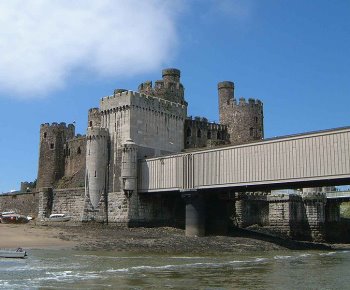
The western end of Stephenson's bridge across the Conwy
right next to the castle.
In the same year Stephenson and William Fairbairn's, Britannia Bridge across the Menai Strait, was opened. This bridge had the novel design of wrought-iron box-section tubes to carry the railway line inside them, because a tubular design using wrought-iron gave the greatest strength and flexibility. The Conwy railway bridge between Llandudno Junction and Conwy was built in 1848 using a similar design. The Conway and Britannia bridges were such a success that Stephenson applied the design to other bridges, two in Egypt, and the 6,588 foot long Victoria Bridge over the St Lawrence River at Montreal in Canada. This was built as one long tube made up of 25 sections. The design was rarely used owing to the cost, and few now remain, the best preserved being the Conwy bridge, which is still used by trains. Other bridges include, Arnside Viaduct in Cumbria, and a joint road and rail bridge in 1850 over the River Nene, at Sutton Bridge in Lincolnshire.
One of Stephenson's few failures was his design of the Dee bridge, which collapsed under a train. Five people were killed. He was heavily criticised for the design, even before the collapse, particularly for the poor choice of materials, which included cast iron. In fact, he had used cast iron for bridge designs before, as had Brunel, but in this case he used longer 98 feet (30 m) girders than used previously, and their great length contributed to the failure. Stephenson had to give evidence at the inquest and this proved to be a harrowing experience. Fellow engineers such as Joseph Locke and Brunel who were called as witnesses at the inquiry, refused to criticise Stephenson, even though they rarely used cast iron themselves. A large number of similar bridges had to be demolished and rebuilt to safer designs.
Robert Stephenson's advice on railway matters was sought after in various countries. In France, he advised his friend the French engineer Paulin Talabot during the years 1837 to 1840 on the construction of the Chemins de fer du Gard from Beauvoir to Alès. He made journeys to Spain to advise on the construction of the railway from the Bay of Biscay to Madrid, and he visited the line Orléans - Tours.[3]
On Prosper Enfantin's initiative, he and Talabot and Alois Negrelli became members of the Société d'Études du canal de Suez in 1846, where they studied the feasibility of the Suez canal. In late 1850, he was called by the Swiss Federal Council to advise on the future Swiss railway net and its financial implications.[4][5] From 1851 to 1853, he built the railway from Alexandria to Cairo, which was extended to Suez in 1858.[6]
Robert Stephenson served as Conservative Member of Parliament for Whitby from 1847 until his death. Within the Tory party, he sat on right-wing[citation needed], at that time hostile to free trade[citation needed], and Stephenson appeared anxious to avoid change in almost any form[citation needed] . He was a commissioner of the short-lived London Metropolitan Commission of Sewers from 1848. He was President of the Institution of Civil Engineers, for two years from 1855.
Robert’s father George died in 1848 aged 67. Robert died on 12 October 1859 at his London home aged 55. Fellow engineer Brunel had died one month earlier on 15 September 1859. Robert was buried in Westminster Abbey next to Thomas Telford. Queen Victoria gave special permission for the cortege to pass through Hyde Park and 3,000 tickets were sold to spectators. In his eulogy, he was called ‘the greatest engineer of the present century’. In his will he left nearly £400,000.
The Stephenson Railway Museum in North Shields is named after George and Robert Stephenson.
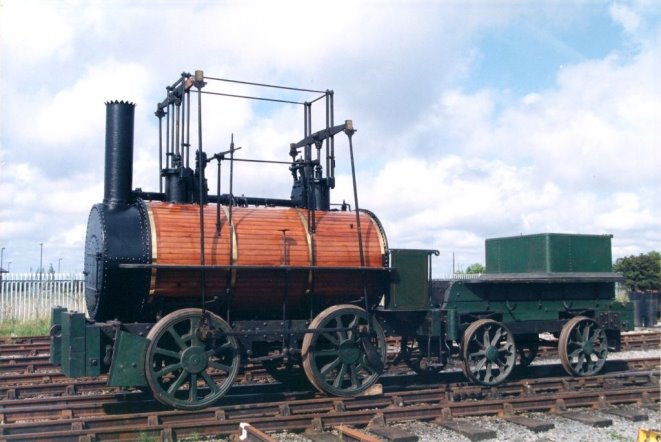
George Stephenson's 'Billy', a forerunner of the world- famous Rocket.
Stephenson was god-father to Robert Baden-Powell, whose full name was Robert Stephenson Smyth Baden-Powell, the first two in honour of his godfather, the third his mother's maiden name.
He is buried in the Nave of Westminster Abbey
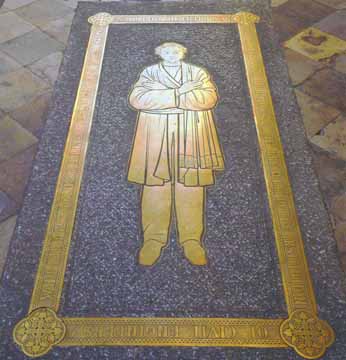
Gravestone and memorial window
A brass over his grave, designed by Sir Gilbert Scott, shows him in contemporary dress with his arms folded. The inscription reads:
“SACRED TO THE MEMORY OF ROBERT STEPHENSON M.P. D.C.L. F.R.S. etc. LATE PRESIDENT OF THE INSTITUTION OF CIVIL ENGINEERS WHO DIED 12th OCTOBER A.D. 1859 AGED 56 YEARS”.
A stained glass window was erected near the grave in 1862, designed by William Wailes but amended by Sir Gilbert Scott. This was moved in 1934 to the north choir aisle. The order of the medallions was changed at this time and plain glass substituted for the original coloured background. At the top are portrait heads of his father George, Thomas Telford, John Smeaton, Robert himself, James Watt and John Rennie. Depictions of Robert’s bridges over the Nile, the St Lawrence river in Canada, the Tyne and the Menai Straits appear, together with scenes showing Biblical building projects. Smaller portrait heads of famous builders of history also appear including Noah, Cheops, Hiram, Euclid, Archimedes, Michaelangelo and Christopher Wren. In 1948 a representation of the Rocket locomotive was added at the base of the window and the inscription was altered to include his father’s name. The inscription reads:
“Robert Stephenson MP,DCL,FRS 1803-1859 President of the Institution of Civil Engineers son of George Stephenson 1781-1848 Father of Railways”.
Born: 16 Oct, 1803
Died: 12 Oct, 1859
Field: Engineer
Location in the Abbey: Nave, north choir aisle
Type of memorial: Grave; window
Type of material: Brass
From Westminster Abbey website:
Robert Stephenson, called the greatest engineer of the nineteenth century, was buried beside Thomas Telford in the centre part of the nave of Westminster Abbey. He was born on 16 October 1803 near Newcastle upon Tyne, the only son of George Stephenson, railway engineer, and his wife Frances (Henderson). He studied in Newcastle and Edinburgh and then became manager of the firm of Robert Stephenson & Co, founded for him by his father, and later spent some time in Columbia on mining projects. On 17 June 1829 he married Frances Sanderson but they had no children. His steam engine Rocket was entered for the Rainhill Trials in 1829 and won the prize. He is remembered also for his civil engineering work especially railway bridges. In 1847 he became Member of Parliament for Whitby and was later elected a Fellow of the Royal Society but he declined a knighthood. He died on 12 October 1859.
Gravestone and memorial window
A brass over his grave, designed by Sir Gilbert Scott, shows him in contemporary dress with his arms folded. The inscription reads:
“SACRED TO THE MEMORY OF ROBERT STEPHENSON M.P. D.C.L. F.R.S. etc. LATE PRESIDENT OF THE INSTITUTION OF CIVIL ENGINEERS WHO DIED 12th OCTOBER A.D. 1859 AGED 56 YEARS”.
A stained glass window was erected near the grave in 1862, designed by William Wailes but amended by Sir Gilbert Scott. This was moved in 1934 to the north choir aisle. The order of the medallions was changed at this time and plain glass substituted for the original coloured background. At the top are portrait heads of his father George, Thomas Telford, John Smeaton, Robert himself, James Watt and John Rennie. Depictions of Robert’s bridges over the Nile, the St Lawrence river in Canada, the Tyne and the Menai Straits appear, together with scenes showing Biblical building projects. Smaller portrait heads of famous builders of history also appear including Noah, Cheops, Hiram, Euclid, Archimedes, Michaelangelo and Christopher Wren. In 1948 a representation of the Rocket locomotive was added at the base of the window and the inscription was altered to include his father’s name. The inscription reads:
“Robert Stephenson MP,DCL,FRS 1803-1859 President of the Institution of Civil Engineers son of George Stephenson 1781-1848 Father of Railways”.
Photographs of the brass and window can be purchased from Westminster Abbey Library.
Further reading
Oxford Dictionary of National Biography 2004
“Robert Stephenson, Engineer and Scientist...” Victoria Haworth, 2004.
References

Contact us for more info
|
